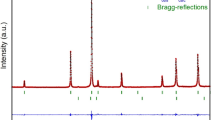Abstract
Based on the corrected phase diagrams proper growth conditions for Li2Zn2(MoO4)3 crystals are selected. Large crystals (up to 100 mm), both impurity-free and activated by transition metal ions (Cu, Cr), are grown by the low-gradient Czochralski method. By the EPR method the charge state and structural position of copper and chromium ions are determined. The performed studies of luminescent properties show that for impurity-free crystals luminescence with λ = 388 nm with a two-exponential luminescence decay with τ1 = 2 ns and τ2 = 6 ns is observed at room temperature. At 77 K for both impurity-free crystals and those activated with transition metal ions luminescence with λ = 560 nm and the luminescence lifetime τ = 100 ns is observed, the intensity of luminescence with λ = 560 nm depending on the nature and concentration of transition metal ions. Cation vacancies responsible for the charge compensation of impurity transition metal ions are assumed to be also responsible for low-temperature luminescence.
Similar content being viewed by others
References
M. Globus, B. Grinyov, and Jong Kying Kim, Inorganic Scintillators for Modern and Traditional Applications, Institute For Single Crystals, Kharkiv (Ukraine) (2005).
M. Kobayashi, M. Ishii, and C. L. Melcher, Nucl. Instr. Meth., A335, 509–512 (1993).
C. L. Melcher and J. S. Schweitzer, IEEE Trans. Nucl. Sci., NS39, 502–505 (1992).
C. Dujardin, C. Pedrini, D. Boutet, et al., Proc. Intern. Conf. “SCINT 95”, P. Dorenbos and C. W. E. van Eijk (eds.), Delft, Netherlands (1995), p. 36.
C. W. E. van Eijk, Nucl. Instr. and Meth., A392, 285–290 (1997).
D. Pauwels, N. Lemasson, B. Viana, et al., Inorganic Scintillators and Their Applications, Proc. Intern. Conf. “SCINT 99”, V. Mikhailin (ed.), Moscow (1999), pp. 511–516.
F. T. Avignone III, G. S. King III, and Yu. G. Zdesenko, New J. Phys., 7, 1–6 (2005).
G. Audi, A. H. Wapstra, and C. Thibault, Nucl. Phys., A729, 337–746 (2003).
E. V. D. Van Loef, P. Dorenbos, C. van Eijk, et al., Appl. Phys. Let., 79, No. 10, 1573–1575 (2001).
M. Kapusta, M. Balcerzyk, M. Moszynski, and J. Pawelke, Nucl. Instr. Meth., A42, 610 (1999).
M. Kobayashi, M. Ishii, K. Harada, et al., Nucl. Instr. Meth., A373, 333 (1996).
J. B. Reed, B. S. Hopkins, L. F. Audrieth, et al., Inorg. Synth., 1, 28 (1936).
K. S. Shah, J. Glodo, M. Klugerman, et al., Nucl. Instr. Meth., A505, 76 (2003).
R. Zhu, Inorganic Scintillators and Their Applications. Proc. Intern. Conf. “SCIN. 97”, Zhiwen et al. (eds.), Shanghai, China (1997), pp. 73–90.
V. B. Mikhailik, H. Kraus, D. Wahl, and M. S. Mykhaylyk, Phys. Stat. Sol., B242,17 (2005).
Yu. G. Zdesenko, B. N. Kropivyanskii, V. N. Kuts, et al., Instrum. Exp. Tech., 39, 362–366 (1996).
L. Xue, Y. Wang, P. Lv, et al., Cryst. Growth Design., 9, 914–920 (2009).
L. Xue, Z. Lin, F. Huang, and J. Liang, Chinese J. Struct. Chem., 26, No. 10, 1208–1210 (2007).
V. A. Efremov and V. K. Trunov, Z. Neorg. Khim., 20, 2200–2203 (1975).
V. A. Efremov, Yu. G. Petrosyan, and V. M. Zhukovsky, Z. Neorg. Khim., 22, 175 (1977).
S. F. Solodovnikov, Z. A. Solodovnikova, E. S. Zolotova, et al., J. Solid State Chem., 182, 1935–1943 (2009).
A. A. Pavlyuk, Ya. V. Vasiliev, L. Yu. Kharchenko, and F. A. Kuznetsov, Proceed. of the Asia Pacific Society for Advanced Materials APSAM-92, Shanghai (1992), p. 164
V. A. Nadolinny, N. V. Chernei, A. V. Sinitsyn, et al., J. Struct. Chem., 49, No. 5, 859–864 (2008).
Author information
Authors and Affiliations
Corresponding author
Additional information
Original Russian Text Copyright © 2011 by V. A. Nadolinny, A. A. Pavlyuk, S. F. Solodovnikov, Z. A. Solodovnikova, E. S. Zolotova, N. A. Nebogatikova, V. F. Plyusnin, and A. A. Ryadun
__________
Translated from Zhurnal Strukturnoi Khimii, Vol. 52, No. 4, pp. 730–734, July–August, 2011.
Rights and permissions
About this article
Cite this article
Nadolinny, V.A., Pavlyuk, A.A., Solodovnikov, S.F. et al. Structure and properties of Li2Zn2(MoO4)3 crystals activated with copper and chromium ions. J Struct Chem 52, 708–712 (2011). https://doi.org/10.1134/S0022476611040093
Received:
Revised:
Published:
Issue Date:
DOI: https://doi.org/10.1134/S0022476611040093



